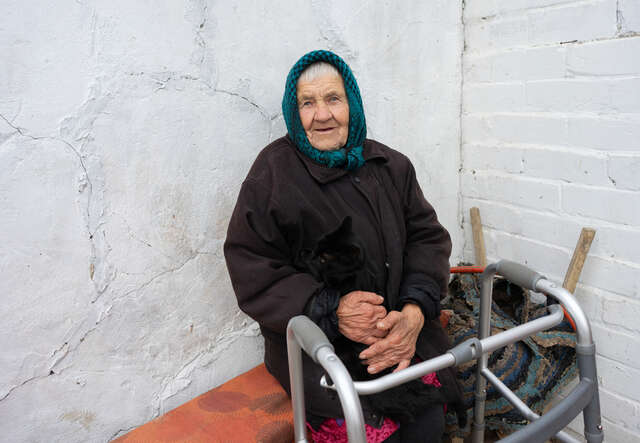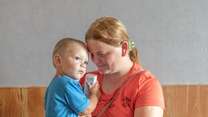
As Ukraine endures another harsh winter, millions are struggling to stay warm with depleted resources and little to no savings to carry them through the cold months. Drone and missile strikes are taking an even heavier toll this year. Civilian casualties have surged dramatically in 2025, while widespread destruction of homes and critical infrastructure has left communities exposed to freezing temperatures. This could be Ukraine’s toughest winter since the full-scale invasion began in February 2022.
More than 12.7 million people urgently need humanitarian assistance, and as temperatures drop and airstrikes intensify, conditions will worsen.
Since February 2022, the International Rescue Committee (IRC) has been on the ground in Ukraine, providing support to millions of people affected by the war.
This winter, we are providing cash assistance to help people purchase blankets, coats, heaters and fuel for stoves, so they can stay safe through the coldest months. Our medical teams continue to respond where support is needed most—from frontline villages to remote communities—ensuring that women and children, the elderly and people living with chronic conditions get the essential care they deserve.
What are conditions like in Ukraine?
Conflict has shaken eastern Ukraine since 2014, but the situation has drastically worsened since the full-scale war began in February 2022. Civilians have not been spared—more than 53,000 civilian casualties have been recorded since 2022, and the number continues to rise. Civilian casualties from January to October 2025 were 27% higher than the same period in the previous year.
Intensified attacks on Ukraine’s energy infrastructure and residential areas have made life especially challenging, particularly in areas facing the heaviest fighting. Nearly 3.7 million remain displaced within Ukraine, and nationwide estimates suggest that nearly 2 million homes have been destroyed.
Damage to Ukraine’s power grid has resulted in daily blackouts that can last up to 20 hours, disrupting both electricity and water supplies. Thousands of attacks on hospitals, schools and other essential facilities have also been reported.

How cold is winter in Ukraine?
Winters in Ukraine are cold and snowy, with temperatures often plunging well below freezing. From December to March, average temperatures range between 23 degrees Fahrenheit (-4.8 C) and 36 degrees Fahrenheit (2 C). In some regions where the IRC works, temperatures regularly drop as low as -5 degrees Fahrenheit (-21.6 C).
Many of the nearly 3.7 million people displaced within Ukraine are living in collective shelters that lack adequate winter protection. On the frontlines, families live in damaged homes, often without reliable heating or electricity.
Who is most vulnerable during the winter in Ukraine?
Humanitarian action is critical as the harsh winter season adds new risks for people already facing displacement, loss of income and damaged infrastructure. While the entire country is affected, the situation is especially concerning in front-line and border communities in eastern Ukraine, such as Kherson, Sumy and Kharkiv. Rural communities face increasing difficulty accessing healthcare, with IRC data identifying a range of challenges that are contributing to medical staff shortages in these areas.
Elderly people are especially vulnerable to the dangers of winter in Ukraine. Many are less mobile and may be physically unable to leave their homes to seek safety. As conflict and cold weather disrupt their communities, the elderly often lose access to everyday services they rely on for food and care.
Limited electricity and communication services have also made it more difficult for families to take care of their parents and grandparents. At times, they may not even know if their family member is still alive.

How to help Ukrainians this winter
The IRC is on the ground in Ukraine, delivering winter cash assistance to families, enabling them to purchase basic necessities, including blankets, coats, heaters and fuel for stoves. Cash support allows people to make choices based on their immediate needs, giving families both dignity and flexibility during the coldest months.
Beyond our dedicated winter response, the IRC supports health facilities and provides health and legal consultations to displaced Ukrainians whose homes have been damaged in the war. The IRC and our partner organizations have also set up "safe healing and learning spaces" for displaced women and children and are working to ensure the needs of women, children and the elderly are met.
After nearly four years of full-scale war, humanitarian needs in Ukraine remain immense. Support from donors like you make the IRC’s lifesaving work possible.
More from the IRC
The International Rescue Committee has over 90 years of experience helping people affected by crisis in more than 40 countries to survive, recover and rebuild their lives. We also help refugees and displaced people resettle and integrate into new communities in the U.S. and across Europe.
Our ratings: We consistently earn top marks from charity watchdog groups for our efficient use of donor contributions and the effectiveness of our work.
Get connected: Follow the IRC on Instagram, LinkedIn, Facebook, Bluesky and X.
Stay informed: Learn more about the world’s most pressing crises and what the IRC is doing to help.




